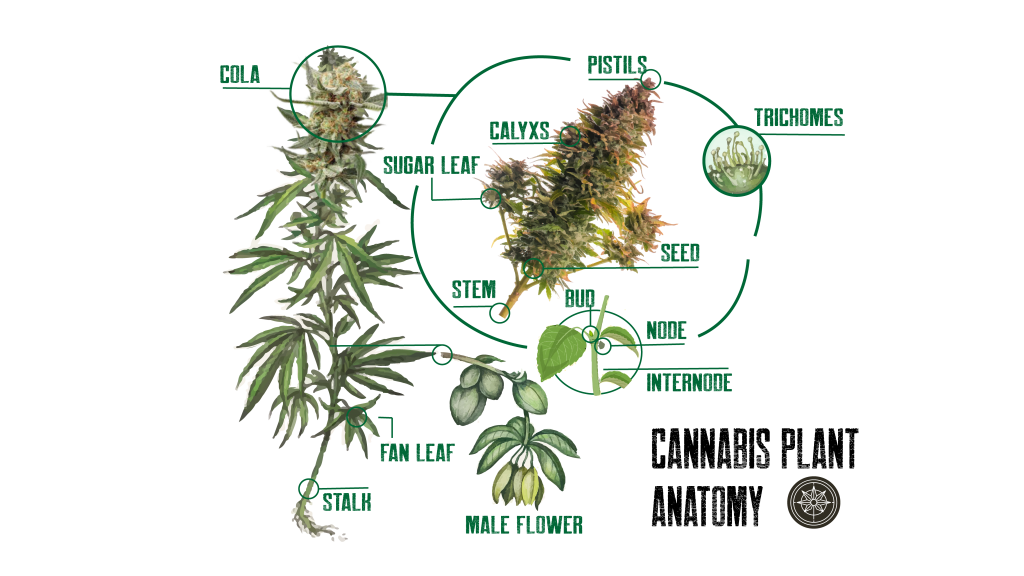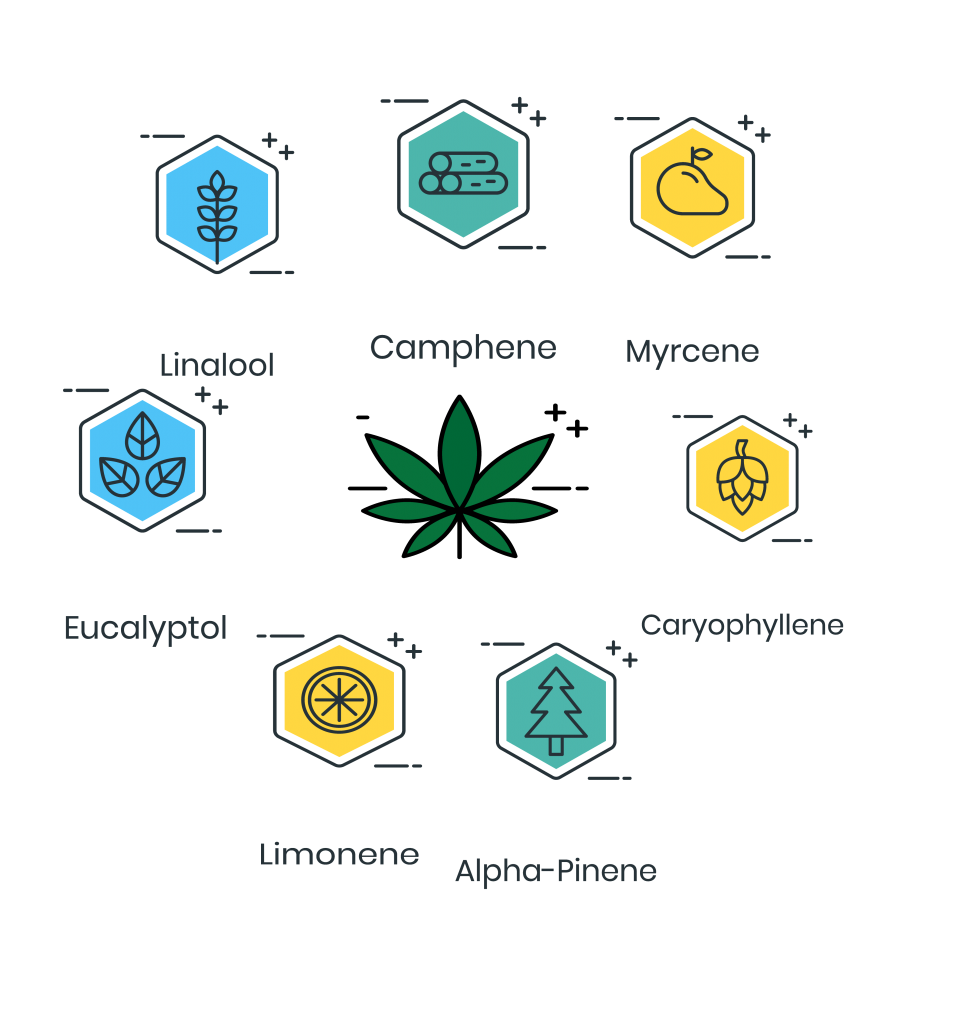
Plant Anatomy - The Cannabis Plant
Cannabis is a versatile plant that has been used around the world for years. Originating in Asia, it made its way to North America due to its value in being a fast-growing and useful source of leaves, seeds, and oil. Hemp is a variety of the plant that has been cultivated for centuries for everyday use. At the same time, cannabis is bred primarily for its psychoactive and health effects. Users will notice different effects and aromas when consuming cannabis, depending on what type of strain it is and where in the world it was grown.
However, some key features are the same across all strains.
In this Cannabis guide we look at:
- Cannabis Plant Anatomy – What is the Cannabis plant?
- Cannabinoids, Terpenes, and Flavonoids – How does the cannabis plant work?
- Cannabis Plant Types – Sativa, Indica, Hybrid
Cannabis Plant Anatomy
Cannabis leaves have a distinct serrated leaf and veins that branch out from the leaf’s base near the stem. The most important part of the plant for cannabis consumers is the trichomes. These fuzzy little crystal-like structures cover the leaves of the plant. Trichomes are small cannabinoid factories, producing the compounds that contribute to different effects from pain management to the relaxing feeling of being high.
Cannabis plants can be male or female. While the male is needed to pollinate, the female variety is the most cultivated because it develops large colas or clusters of flowers, containing the cannabinoids, terpenes, and flavonoids that give consumers many desirable effects. The male tends to have a thicker, sturdier stalk, and fewer leaves and buds, instead producing pollen sacks meant for reproduction. Due to their higher concentration of active chemicals, females are often cloned to maintain the consistency of a given strain and have long, protruding hairs called pistils that take in pollen from the male.
The plant can sometimes be hermaphroditic, having qualities of both the male and female, and can pollinate itself. Lucky bud!

Cannabinoids, Terpenes, and Flavonoids; How does the Plant work?
Cannabinoids
There are hundreds of cannabinoids present in the trichomes of cannabis, and research is ongoing into each one’s benefits. Cannabinoids are chemical compounds that attach to the human body’s endocannabinoid receptors in the central nervous system. The most recognizable cannabinoids are Tetrahydrocannabinol (THC) and Cannabidiol (CBD). The common distinction is that THC produces the psychoactive “high” associated with recreational use, while CBD is the compound used for anti-inflammatory and medicinal purposes. Less commonly known and understood are
- Cannabigerol (CBG), a non-psychoactive compound shown to slow bacterial growth and reduce inflammation;
- Cannabichromene (CBC), a pain reliever; and
- Cannabinol (CBN), a mild psychoactive and sedative derived from THC.
The effects of cannabinoids like THC differ based on how they are ingested. THC is somewhat unpredictable in how effectively it attaches to cannabinoid receptors. One should always err on the side of caution when consuming cannabis to get high. Since both THC and CBD are found in most consumable cannabis products, they are often said to have an “entourage effect,” meaning that CBD can increase the potency of THC’s effects even though it does not produce these effects on its own.
Terpenese
Terpenes give cannabis its many appetizing aromas but are primarily secreted to repel predators of the plant. While terpenes are also present in other plants, they are highly concentrated in cannabis. They are naturally occurring, and like cannabinoids, terpenes also affect the endocannabinoid system. Meanwhile, flavonoids, which are found in many different plants like vegetables and fruits, affect the pigmentation, aroma, and flavour of the weed. This synergy is manifested in the thousands of different strains of weed on the market.
Together, cannabinoids, terpenes, and flavonoids bind to the body’s cannabinoid receptors and produce a myriad of different effects.

Sativa, Indica, and Hybrid Cannabis Strains
Cannabis cultivated for recreational use is typically divided into three categories: sativa, indica, and hybrid. They are differentiated by their chemical makeup, namely the previously mentioned cannabinoids and terpenes. These can be found in the plant’s secretions but are found in their highest concentration in the trichomes. The trichomes protect the plant from its environment and produce the various effects that recreational and medicinal users are looking for.
Sativa is usually known as being an “upper,” perfect for a wake and bake, or for getting together with friends (or why not both?). Some of the most popular sativas to try include the pungent Sour Diesel and the citrusy Lemon Haze. Green Crack is another favourite that can help you jumpstart your day with its fruity flavours.
Indicas are known more for their ability to help consumers relax and drift off to Dreamland, and for pain relief. They’re great for helping manage anxiety, or for an extra blissful evening of Netflix and chill. One of the most famous indica strains is Northern Lights. Fans of The Office will remember when Creed identified it during the episode “Drug Testing.”
Cannabis Striains
Other irresistible indicas include Blueberry, with its beautiful purple buds, the mouthwateringly sweet Grape Ape, and Bubba Kush, a stoner’s favourite sedative.
Hybrids are, as one would expect, a mix of sativa and indica. They can bring you up or help you come down. They can affect both your mind and your body. Hybrids are an excellent choice for the new cannabis user who isn’t sure exactly what type of high they want to achieve. OG Kush is one of the most popular hybrid strains, followed by Blue Dream and Gorilla Glue.
Be sure to take note of the effects you feel as you consume different strains. Not every sativa will bring you up, and not every indica will relax you.
The Future of Cannabis
The cannabis plant has been cultivated for centuries, but we are still constantly learning new things about the plant and its effects on humans.
With a little bit of research and experimentation (most fun research ever!), and with help from our guides at Due North Cannabis, you can find the perfect strain for your specific needs.
